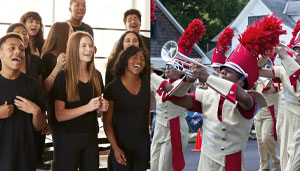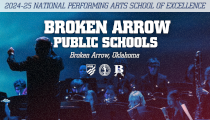Seven Strategies for Interpreting Articulation in Your Big Band
By Dr. Keith Karns on July 19, 2023 advocacy PrintIt is jazz festival season! All across Oregon, thousands of high school music students compete in jazz festivals in order to demonstrate their hard work, get feedback from knowledgeable judges, and ultimately dig deeper into this music. I judge many of these festivals. Recently I heard twenty-eight bands at a regional festival in my area. All of the bands played well, but by and large the handful of truly great performances I heard all had one thing in common: a commercial approach to articulation.
Articulation is one of the most expressive elements in music. It is one of the main ways we communicate style and energy to our audience. Articulation places phrases in time, and provides energy to a line. In commercial music—that is to say jazz, funk, rock, pop, Latin, etc.—we use what is known as commercial articulation or a commercial attack. This is what gives the music its zing, panache, and forward momentum. Simply put, commercial articulation is what makes a band sound tight.
Commercial articulation is very different than what we want to do in wind ensemble, orchestra, or even a jazz combo. Understanding how to interpret articulations is one of the most challenging aspects young bands face. Fortunately, there are some basic principles for interpreting commercial articulation that we can employ in virtually all jazz styles. I have compiled them into seven basic principles that will help us better understand how to get more music out of our bands.
1. Imitate What You Hear on the Recording
This is the cardinal rule of all jazz. The recording—not the parts or the score—dictates how the music is to be interpreted.
In my rehearsals, I play recordings constantly. These are usually short excerpts no more than ten or twenty seconds long. Each excerpt I play directs student attention to specific stylistic details in the music. Immediately after I play the recording, I ask my students to imitate what they hear. This creates a learning environment where all student performance is informed by a detailed study of iconic recordings. If you do not like the way your students play something, it is usually a sign that you need to direct their attention to the recording.
2. All Accents are Exaggerated
All accents must be exaggerated. I mean really exaggerated. This means that when a note has an accent, we don’t kind of accent it, WE HIT THAT NOTE HARD! For students not used to playing in a horn section, this attack can feel like we are overdoing it.
I like to think about this exaggerated articulation as similar to how a Shakespearian actor says their lines. The Shakespearian actor will spit out even the most tender of lines, overenunciating to the point where they may be spitting on audience members in the first row. If you ran into a person talking in a supermarket in the style of a Shakespearian actor, you might assume that person was unwell. But when you go see Coriolanus, or The Tempest, you would be disappointed if the actors were not enunciating in that way. It is the same when we play commercial music in a horn section. We are not playing the way we would play a solo, we are spitting the music out to the back of the hall.
3. The First Note in a Phrase Gets an Accent
Speaking of exaggerated accents, when we begin a phrase, we need to nail the heck out of the first note in the phrase. This accent places the beginning of the phrase in time, and propels it forward. Again, we want a hyper-aggressive, overenunciated approach to the articulation.
Without this accent, you may notice that your horns aren’t playing in the pocket, there are time problems, or the horn lines sound boring. How will you tell if the first note is accented enough? Refer to step one in this guide.
4. Anything Marked Short is Played SHORT
If you have a note marked with a rooftop accent or a staccato, it is to be played SHORT! Every note marked short should be hit very hard with a hyper-aggressive, over enunciated attack. My number one critique of young bands is that they do not hit short notes hard enough and they do not play short notes short enough. The desired effect is one of general stabyness (????) coming from the horn section.
Now, I know some of you might be thinking of Earol Gardner’s fantastic lead trumpet playing with the Mel Lewis Orchestra in the 1980s. Earol played very fat articulations that might not best be described as short. Like most of the guidelines here, there are exceptions. In regard to note length, I will say two things. (1) Playing notes marked short with a very short, very aggressive attack is a good first approach to playing this music. This will be effective on most tunes, particularly the music of Count Basie. (2) If you think the chart you are working on is an exception to this rule, be sure to consult the recording.
5. Eighth Notes and Quarter Notes Followed by a Rest are SHORT
I call this buttoning a phrase. Any time we have eighth notes or quarter notes followed by a rest, they are almost always played short with a hyper-aggressive attack. This functions as a kind of punctuation mark to the ends of the phrase.
It is important to point out that these notes often appear without any articulation markings at all. Since it is assumed that quarter notes and eighth notes followed by rests are to be played short, many arrangers leave out articulation marks for these notes in order to save time copying parts. This means that the responsibility is on us to interpret this music in line with the style and not necessarily what is on the page. If you are unsure if this is the correct way to play a specific passage, be sure to consult the recording.
6. Eighth Notes Followed by Other Notes Are LONG
You know that ricky-ticky over swung dotted eighth-sixteenth feel that many beginners play with? What makes that sound so unappealing? Sure, it doesn’t swing, but why? I would say that ricky-ticky sound usually comes from just a tiny bit of space in between the eighth notes. This space ruins any forward motion the line might have. This can be compounded when you try and get your band to use a commercial attack.
When we play swung eighth notes, each note should be connected to the next note with no space in between (This does not apply to shuffle rhythms). This should tie into the legato quarter note sound of the walking bass which will tie into the quarter note driven sound of the ride cymbal. If you are unsure how an eighth note line should sound, be sure to consult the recording.
7. Cutoffs are Important
Where we cut off long notes is critically important. The cutoff places the end of the note in time. This is almost always done with a tongue stop on a downbeat. This means the tongue is literally stopping the air at the end of the note. It should sound like the end of the note was sliced off with a razor blade.
The general rule for cutoffs is that they are cut off on the next beat. A whole note is cut off on beat one of the next bar, half note on beat 3, etc. There is a fair amount of leeway on when something could be cut off so it is best to consult your lead players when making these decisions.
Without this cutoff, your long notes will lose their energy and your band will sound sloppy. I cannot tell you how many times I have heard a band absolutely nail a tough chart only to have their good work ruined by a raggedy cutoff on the first half note that came their way. If you are unsure about where a note should be cut off, be sure to consult the recording.
What This Looks Like in Music
Here is a pretty typical big band phrase you might see in a lead trumpet part. Note that some accents are marked, but not all. For example, even though the first note on beat three is not marked we should still hit that note with a hard accent. Since beat three is an eighth note followed by another note, the eighth note should be played long. Similarly, the eighth notes in m. 2 on beats one and two should be played long. In m. 2, the eighth note on the and of two should be played short even though it is not marked. This is because it is an eighth note followed by a rest. The dotted quarter note on the and of three should be hit hard with an accent as it is marked. It should also be cut off with a tongue stop on beat one. If your band plays like this, they will sound tight. If they do not, they will sound sloppy.
Be Tenacious
In my experience, you won’t be able to get your band to interpret the music this way overnight. Bands who have learned to play this way have spent a huge amount of time painstakingly studying recordings and imitating that sound. Your goal should be for these guidelines to form a baseline approach for student interpretation of all jazz and commercial music. It will take years of work to develop these habits. You can’t say this stuff once and expect it to work. You can’t even say this stuff once every rehearsal and expect it to work. You can’t say it two or three times every rehearsal. When your band doesn’t listen to you, you can’t give up and move on. You need to be prepared to spend an hour on four measures of music. Those rehearsals will probably look something like this:
a. Direct student attention to a specific musical goal, for example “I want those rooftop accents SHORT!”
b. Listen to the excerpt in question played by an iconic band
c. Have your band play the same excerpt
d. Unless your band has achieved the given goal say “No that is not it.”
e. Repeat steps a-d until either you have all died of old age or they have achieved the given goal.
f. Move on to the next spot and repeat steps a-e.
There is no silver bullet to transform a young band into a road-tested professional group overnight. My advice for anyone who wants to get more music out of their band is to focus on the style. You will not be able to think about style without spending a significant portion of time analyzing articulation. How do the beginnings of phrases sound? What do the short notes sound like on an iconic recording? Where are the cutoffs? The more you can get your band to be focusing on these things and imitate what they hear on iconic recordings, the better they will sound.
Throughout this article I have advised you to listen to iconic recordings. There is no shortage of fantastic big band records out there, but here are some of the ones I think are essential for everyone to own:
Count Basie, Chairman of the Board; Count Basie, Frankly Basie; Count Basie, Atomic Basie; Count Basie, Live at the El Morocco, Duke Ellington, Live at Newport 1956; Duke Ellington, The Ellington Suites; Stan Kenton, Contemporary Concepts; Jimmy Smith/Oliver Nelson, Bashin’: The Unpredictable Jimmy Smith; Thad Jones/Mel Lewis, Consummation; Thad Jones/Mel Lewis; New Life; Mel Lewis, 20 Years at The Village Vanguard; Maynard Ferguson, Come Blow Your Horn; Vanguard Jazz Orchestra, Lickety Split; Jim McNeely, East Coast Blowout; Bill Holman, View From the Side; Clayton/Hamilton, Live at the MCG; Maria Schneider, The Pretty Road; Darcy James Argue, Infernal Machines; John Hollenbeck, Songs I Like a Lot.
As I say in all of my clinics, it is literally my job to help anyone reading this article become a better jazz musician and jazz educator. I have dedicated my life to that cause. If there is anything I can do to help you to get deeper into this music, do not hesitate to reach out!
Dr. Keith Karns
Dr. Keith Karns is a trumpet player, composer, arranger, and jazz educator based in Salem, Oregon. He has worked with Rich Perry, Lauren Sevian, Greta Matassa, Benny Golson, the Kansas City Jazz Orchestra, the One O’Clock Lab Band, and Stefon Harris. Keith Karns has a DMA in Jazz Studies from the University of North Texas. Keith is the Director of Jazz Studies at Western Oregon University. This article first appeared in the Spring 2020 edition of the Oregon Music Educator. The Oregon Music Education Association promotes excellence in music education and serves the professional needs of its members.Check out the Oregon Music Educators Association here: (https://www.oregonmusic.org/)
Most Recent Articles







